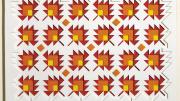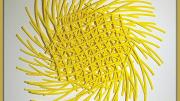During his 40-plus years as an architect, Robert Pillsbury ’61, M.Arch. ’65, devoted himself to the pleasures of creation and construction, often in the form of large-scale industrial water and sewer systems he helped design. Now retired, his materials of choice have shifted to the lighter medium of paper. Inspired by everything from the natural world and the elegant geometry of quilt patterns and chair caning to Italian abstract artists such as Enrico Castellani and Piero Dorazio, Pillsbury employs an architectural process and aesthetic to create cut-paper compositions that communicate a simultaneous sense of delicate intricacy and substantive dimension.
Pillsbury studied art at Harvard with painter and photographer T. Lux Feininger and dabbled in different projects over the years, at one point creating a series of life-sized birds of prey from discarded cork sheets. It wasn’t until 2009, however, that he started to devote more time to his artwork. “I always felt that you need to have something to retire to—I couldn’t just retire,” says Pillsbury, who reports to his home studio in Warren, Rhode Island, at 8 a.m. every weekday, breaking for lunch and a bike ride before returning for a few more hours of work in the afternoon.
It takes him about 40 hours to craft a piece from start to finish. First, he drafts a design concept on paper freehand before using a software program (SketchUp) to create and manipulate a measured, hardline drawing to print out as a template. Pillsbury places that template over a sheet of heavy, textured paper (typically 80-pound stock) before using a pin to prick each point of the design. He then cuts from pinprick to pinprick with an X-Acto knife, producing one tier of a work that he may build up to have four or five layers. Next, he rotates each layer slightly and separates them with surgically placed, adhesive foam spacers (tweezers come into play here). When viewed head-on, the spacers are virtually invisible, creating a vortex-like, three-dimensional effect that pulls the viewer in for a closer look. Some works are monochromatic; others add a second or third color as a compositional element (see www.rpillsburycutpaperartist.com).
“The order and craftsmanship of the forms are important to me,” says Pillsbury, whose work has been featured in a number of juried shows in the past few years. “I enjoy the physical construction of the pieces—it goes back to my early years as an architect. One of my first projects was building a model of the new Boston City Hall.” Although his primary medium is paper, he has also experimented with thin strips of wood veneer to good effect and is intrigued by the semi-translucent potential of polypropylene.
Pillsbury is interested in moving into larger-scale commissions in mediums other than paper, although he enjoys the (relatively) immediate gratification and independence of his current work when compared to the years-long timeline for industrial projects involving numerous parties. “I should be good for a while,” he says, “as long as my eyesight holds out.”










